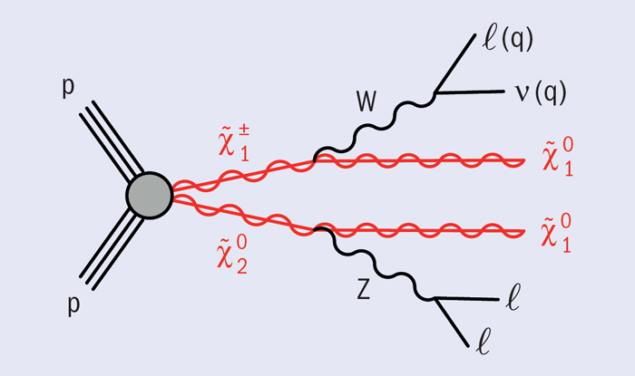The Standard Model is currently the best theory there is of the subatomic world, but it fails to answer several fundamental questions, for example: why are the strengths of the fundamental interactions so different? What makes the Higgs boson light? What is dark matter made of? Such questions have led to the development of theories beyond the Standard Model, of which the most popular is supersymmetry (SUSY). In its most minimalistic form, SUSY predicts that each Standard Model particle has a partner whose spin differs by ½ and an extended Higgs sector with five Higgs bosons. SUSY’s symmetry between bosons and fermions stabilizes the mass of scalar particles, such as the Higgs boson and also the new scalar partners of the Standard Model fermions at high energy. If, as suggested by some theorists, the new particles have a conserved SUSY quantum number (denoted R-parity), the lightest SUSY particle (LSP) cannot decay and primordial LSPs might still be around, forming dark matter.

Two charginos, χ~±1,2, and four neutralinos, χ~01,2,3,4 – collectively referred to as electroweakinos – are the SUSY partners of the five Higgs and the electroweak gauge bosons. Based on arguments that try to accommodate the light mass of the Higgs boson in a “natural”, non-fine-tuned manner, the lightest electroweakinos are expected to have masses in the order of a few hundred giga-electron-volts. The lightest chargino, χ~±1, and the next-to-lightest neutralino, χ~02, can decay into the LSP, χ~01, plus multilepton final states via superpartners of neutrinos (sneutrinos, ν~) or charged leptons (sleptons, l~), or via Standard Model bosons (W, Z or Higgs). If SUSY exists in nature at the tera-electron-volt scale, electroweakinos could be produced in the LHC collisions.
The ATLAS collaboration’s searches for charginos, neutralinos and sleptons use events with multiple leptons and missing transverse momentum from the undetected LSP. The two-lepton (e, μ) search has dedicated selections that target the production of l~ l~, χ~±1χ~∓1 and χ~±1χ~02 through their decays via sleptons or W and Z bosons. Meanwhile, the three-lepton (e, μ, τ) analysis searches for χ~±1χ~02 decaying either via sleptons, staus (the SUSY partner of the τ), W and Z bosons, or W and Higgs bosons. Charginos and neutralinos decaying via Standard Model bosons are more challenging to search for than the decays via sleptons, owing to the smaller branching ratio into leptons. The main backgrounds in the two(three)-lepton search are WZ and Z+jets (tt) production, and these are modelled using Monte Carlo simulation and data-driven methods, respectively.

ATLAS has found no significant excess beyond the Standard Model expectation in either the two or three-lepton SUSY searches. This null result can be used to set exclusion limits on SUSY models, narrowing down where SUSY might exist in nature. For example, the two-lepton analysis sets the first direct limits in a simplified SUSY model of χ~±1χ~∓1, where the chargino decays 100% of the time to a W boson. The selections based on the presence of hadronically decaying τ particles in the three-lepton analysis set exclusion limits for χ~±1χ~02 decaying via W and Higgs bosons.
In some cases, the results of two or more analyses can be combined to strengthen the exclusion limits in a particular SUSY model. This is done for the two and three-lepton searches in a simplified SUSY model of χ~±1χ~02, where the χ~±1 and χ~02 are assumed to decay exclusively via W and Z bosons (figure 1). On its own, the two-lepton analysis excludes χ~±1 and χ~02 masses from 170–370 GeV, while the three-lepton analysis excludes masses from 100–350 GeV. By combining the two searches, the exclusion limit is pushed out much further to χ~±1 and χ~02 masses of 415 GeV for a massless χ~01 (figure 2).
So far, no evidence for SUSY has been observed with the first dataset collected by ATLAS. However, in 2015 the LHC will collide protons at higher energies and rates than ever before. This will be an exciting time as exploration of unchartered territories of higher-mass SUSY particles and rarer signatures begins.
Further reading
ATLAS Collaboration 2014 JHEP 04 169.
ATLAS Collaboration 2104 arxiv:1403.5294, accepted by JHEP.








